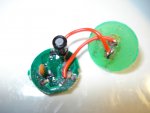roSSco
0
- Joined
- Dec 5, 2007
- Messages
- 649
- Points
- 18
I've been running mine for a couple weeks now @ 100ma w/o any problems, often several minutes at a time.Snytbaggen said:I see... :/ Sorry for asking so much, but what would the current be? And as a side question, is 100mA a safe current for a PHR-803T diode? I recently got in on the GB for them and is trying to find out as much as I can to prevent destroying anything






